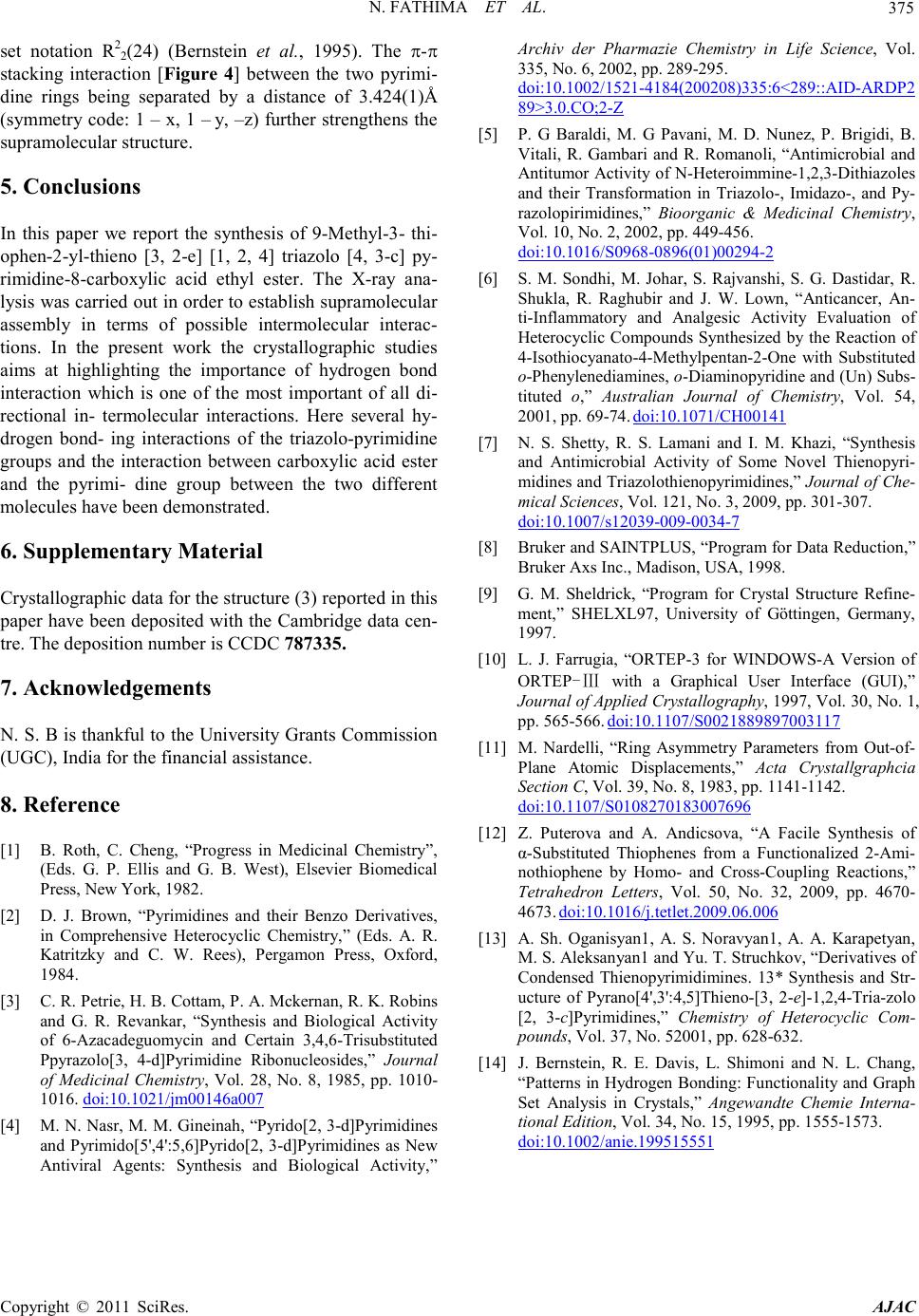
N. FATHIMA ET AL.
Copyright © 2011 SciRes. AJAC
375
set notation R22(24) (Bernstein et al., 1995). The π-π
stacking interaction [Figure 4] between the two pyrimi-
dine rings being separated by a distance of 3.424(1)Å
(symmetry code: 1 – x, 1 – y, –z) further strengthe ns the
supramolecular structure.
5. Conclusions
In this paper we report the synthesis of 9-Methyl-3- thi-
ophen-2-yl-thieno [3, 2-e] [1, 2, 4] triazolo [4, 3-c] py-
rimidine-8-carboxylic acid ethyl ester. The X-ray ana-
lysis was carried o ut in order to establish supramolecular
assembly in terms of possible intermolecular interac-
tions. In the present work the crystallographic studies
aims at highlighting the importance of hydrogen bond
interaction which is one of the most important of all di-
rectional in- termolecular interactions. Here several hy-
drogen bond- ing interactions of the triazolo-pyrimidine
groups and the interaction between carboxylic acid ester
and the pyrimi- dine group between the two different
molecule s have b een demonstrated.
6. Supplementary Material
Crystallograp hic data for the s tructure (3) repo rted in this
paper have been deposited with the Cambridge data cen-
tre. The deposition number is CCDC 787335.
7. Acknowledgements
N. S. B is thankf ul to the Uni versit y Gr ants Co mmissio n
(UGC), India for the financial a ssistance.
8. Referen ce
[1] B. Roth, C. Cheng, “Progress in Medicinal Chemistry”,
(Eds. G. P. Ellis and G. B. West), Elsevier Biomedical
Press, New York, 1 98 2.
[2] D. J. Brown, “Pyrimidines and their Benzo Derivatives,
in Comprehensive Heterocyclic Chemistry,” (Eds. A. R.
Katritzky and C. W. Rees), Pergamon Press, Oxford,
1984.
[3] C. R. Petrie, H. B. Cottam, P. A. Mckernan, R. K. Robins
and G. R. Revankar, “Synthesis and Biological Activity
of 6-Azacadeguomycin and Certain 3,4,6-Trisubstituted
Ppyrazolo[3, 4-d]Pyrimidine Ribonucleosides,” Journal
of Medicinal Chemistry, Vol. 28, No. 8, 1985, pp. 1010-
1016. doi:10.1021/jm00146a007
[4] M. N. Nasr, M. M. Gineinah, “Pyrido[2, 3-d]Pyrimidines
and Pyrimido[ 5',4':5,6]Pyrido[2, 3-d]Pyrimidines as New
Antiviral Agents: Synthesis and Biological Activity,”
Archiv der Pharmazi e Chemistry in Life Science, Vol.
335, No. 6, 2002, pp. 289-295.
doi:10.1002/1521-4184(200208)335:6<289::AID-ARDP2
89>3.0.CO;2-Z
[5] P. G Baraldi, M. G Pavani, M. D. Nunez, P. Brigidi, B.
Vitali, R. Gambari and R. Romanoli, “Antimicrobial and
Antitumor Activity of N-Heteroimmine-1,2,3-Dithiazoles
and their Transformation in Triazolo-, Imidazo-, and Py-
razolopirimidines,” Bioorganic & Medicinal Chemistry,
Vol. 10, No. 2, 2002, pp. 449-456.
doi:10.1016/S0968-0896(01)00294-2
[6] S. M. Sondhi, M. Johar, S. Rajvanshi, S. G. Dastidar, R.
Shukla, R. Raghubir and J. W. Lown, “Anticancer, An-
ti-Inflammatory and Analgesic Activity Evaluation of
Heterocyclic Compounds Synthesized by the Reaction of
4-Isothiocyanato-4-Methylpentan-2-One with Substituted
o-Phenylenediamines, o-Diaminopyridine and (Un) Subs-
tituted o,” Australian Journal of Chemistry, Vol. 54,
2001, pp. 69-74. doi:10.1071/CH00141
[7] N. S. Shetty, R. S. Lamani and I. M. Khazi, “Synthesis
and Antimicrobial Activity of Some Novel Thienopyri-
midines and Triazolothienopyrimidines,” Journal of Che-
mical Sciences, Vol. 121, No. 3, 2009, pp. 301-307.
doi:10.1007/s12039-009-0034-7
[8] Bruker and SAINTPLU S, “P rog ra m for Data Redu ction,”
Bruker Axs Inc., Madison, USA, 1998.
[9] G. M. Sheldrick, “Program for Crystal Structure Refine-
ment,” SHELXL97, University of Göttingen, Germany,
1997.
[10] L. J. Farrugia, “ORTEP -3 for WINDOWS-A Version of
ORTEP -Ⅲ with a Graphical User Interface (GUI),”
Journal of Applied Crystallography, 1997, Vol. 30, No. 1,
pp. 565-566. doi:10.1107/S0021889897003117
[11] M. Nardelli, “Ring Asymmetry Parameters from Out-of-
Plane Atomic Displacement s ,” Acta Crystallgraphcia
Section C, Vol. 39, No. 8, 1983, pp. 1141-1142.
doi:10.1107/S0108270183007696
[12] Z. Puterova and A. Andicsova, “A Facile Synthesis of
α-Substituted Thiophenes from a Functionalized 2-Ami-
nothiophene by Homo- and Cross-Coupling Reactions,”
Tetrahedron Letters, Vol. 50, No. 32, 2009, pp. 4670-
4673. doi:10.1016/j.tetlet.2009.06.006
[13] A. Sh. Oganisyan1, A. S. Noravyan1, A. A. Karapetyan,
M. S. Aleksan yan1 and Yu. T. Struchkov, “Derivatives of
Condensed Thienopyrimidimines. 13* Synthesis and Str-
ucture of Pyrano[4',3':4,5]Thieno-[3, 2-e]-1,2,4-Tria-zolo
[2, 3-c]Pyrimidines,” Chemistry of Heterocyclic Com-
pounds, Vol. 37, No. 52001, pp. 628-632.
[14] J. Bernstein, R. E. Davis, L. Shimoni and N. L. Chang,
“Patterns in Hydrogen Bonding: Functionality and Graph
Set Analysis in Crystals,” Angewandte Chemie Interna-
tional Edition, Vol. 34, No . 15, 1995, pp. 1555-1573.
doi:10.1002/anie.199515551